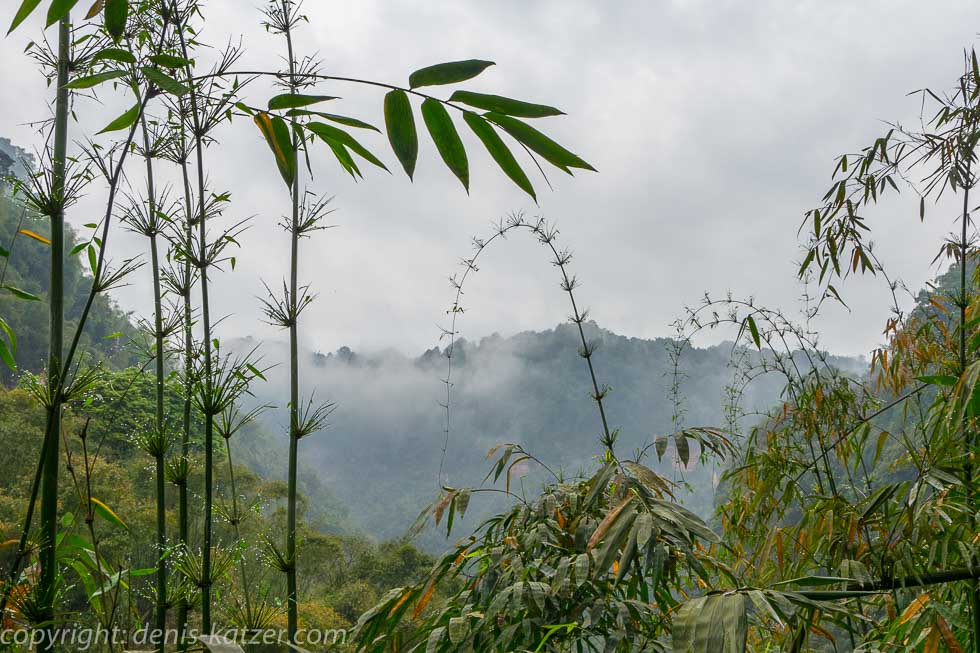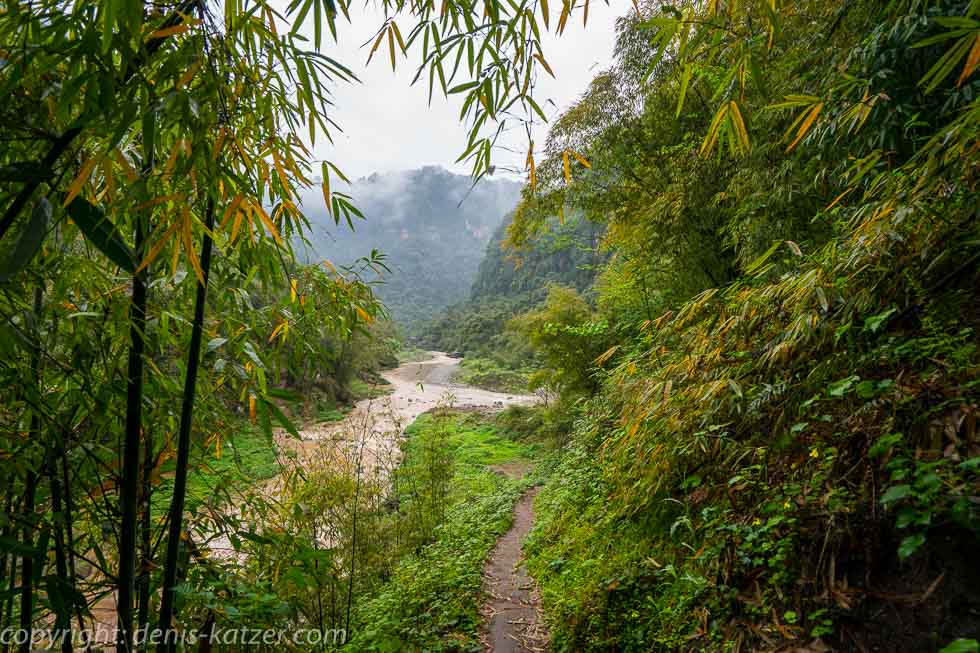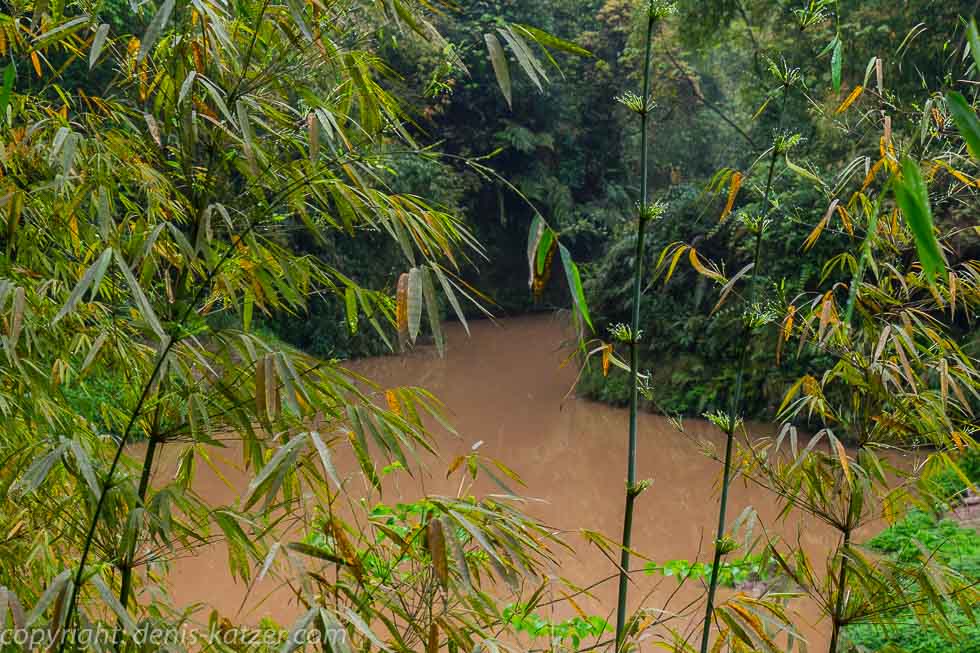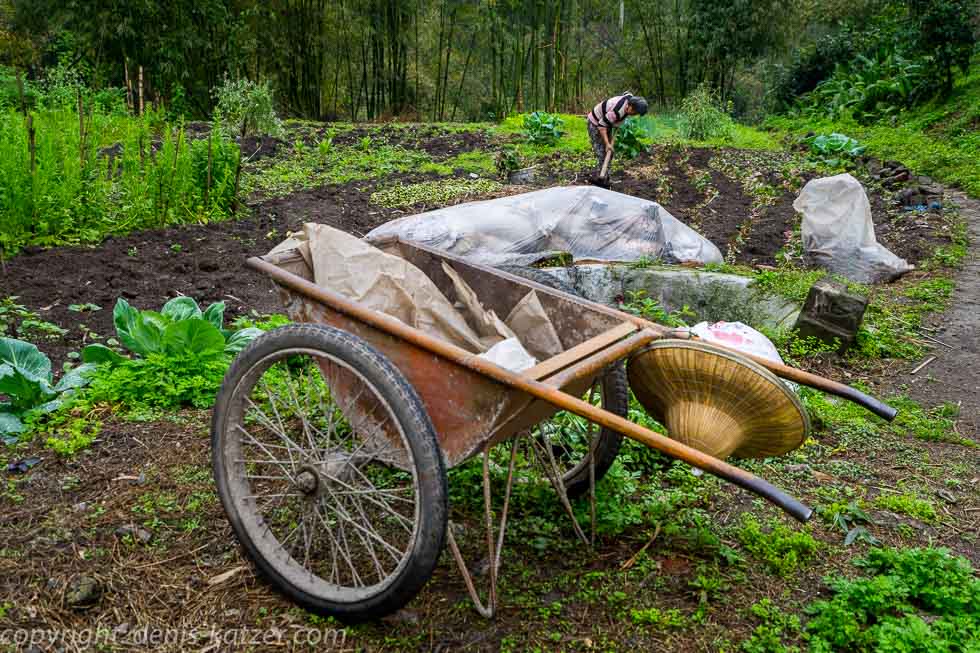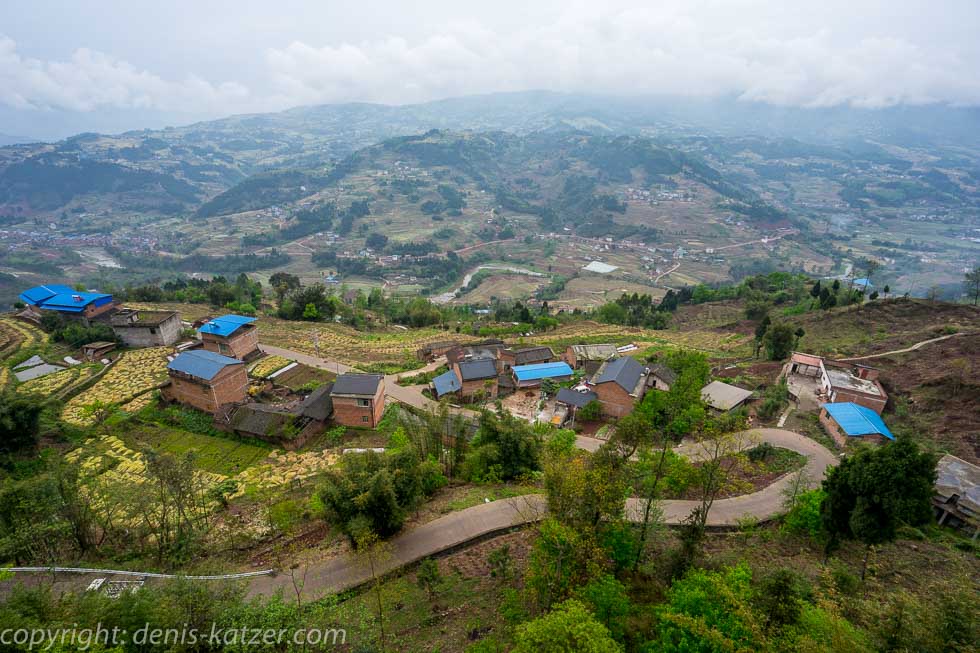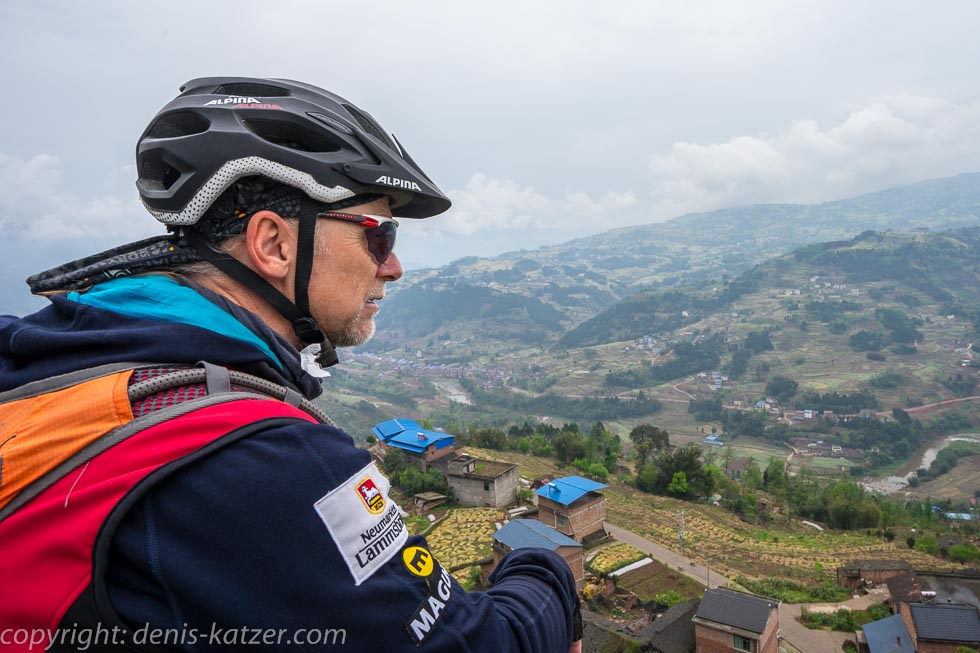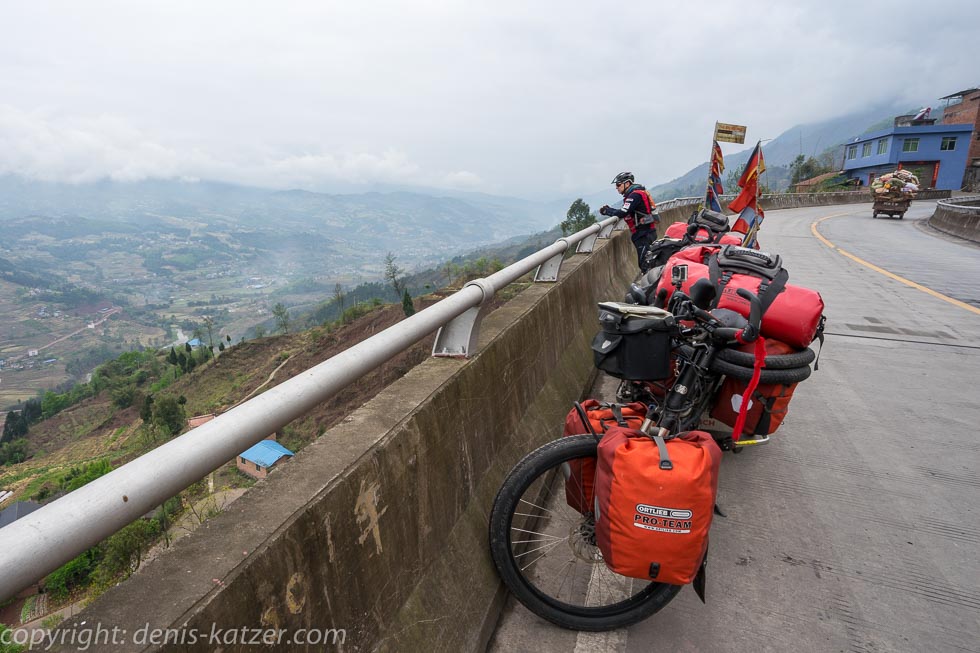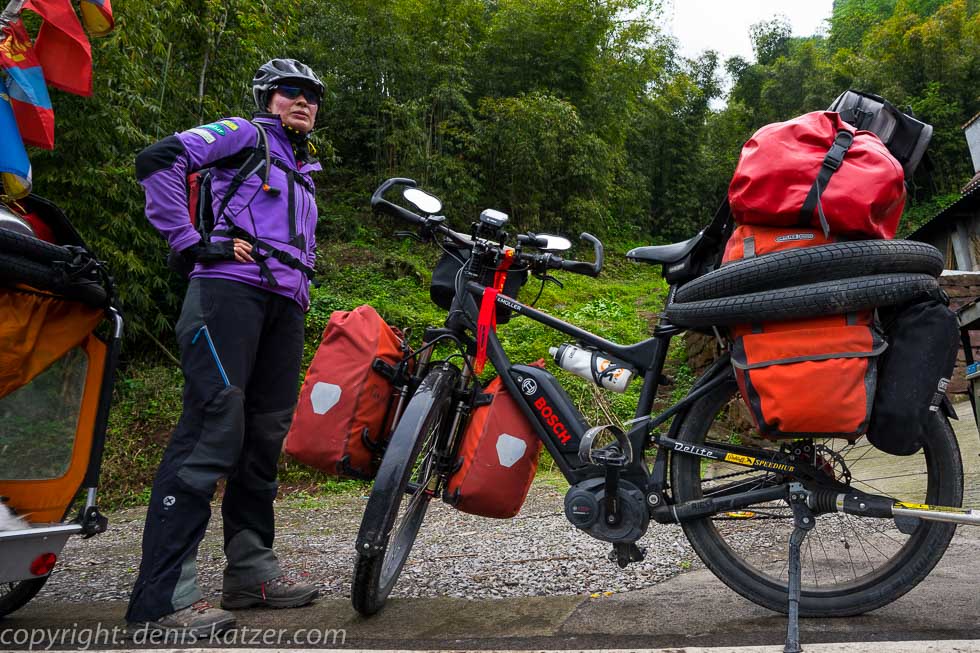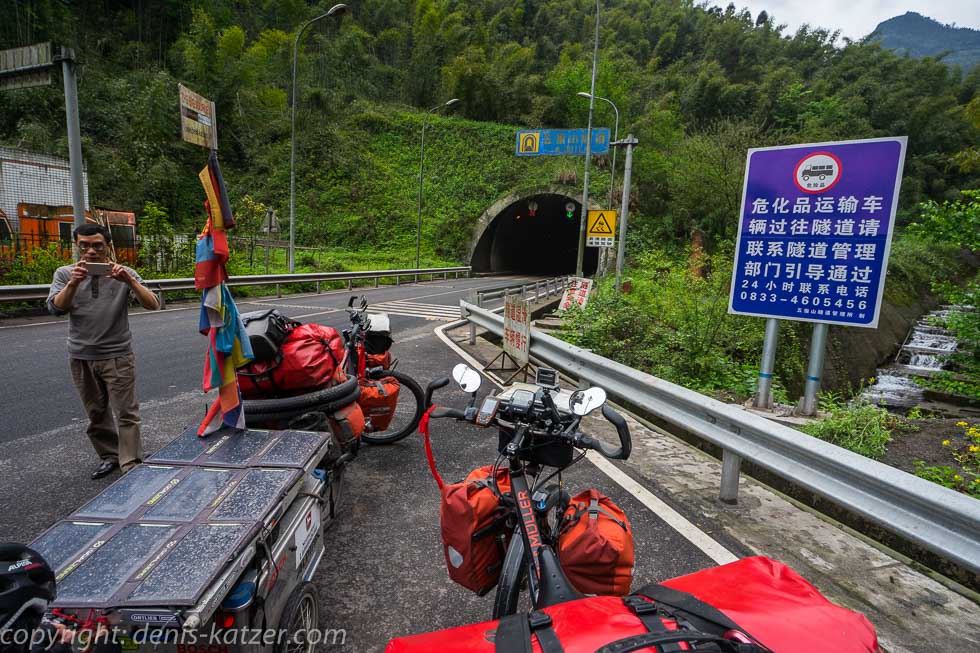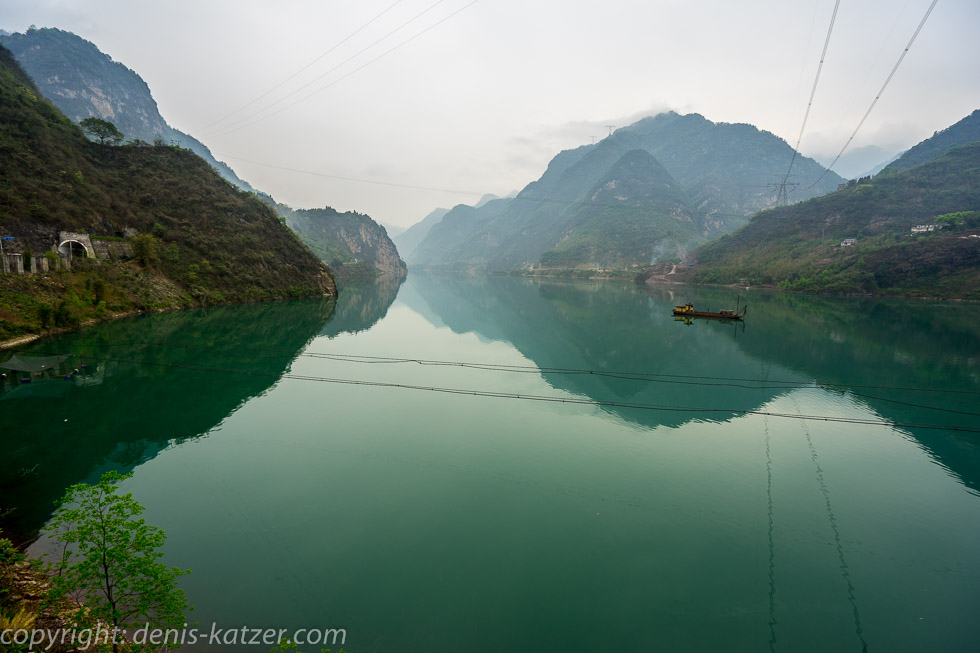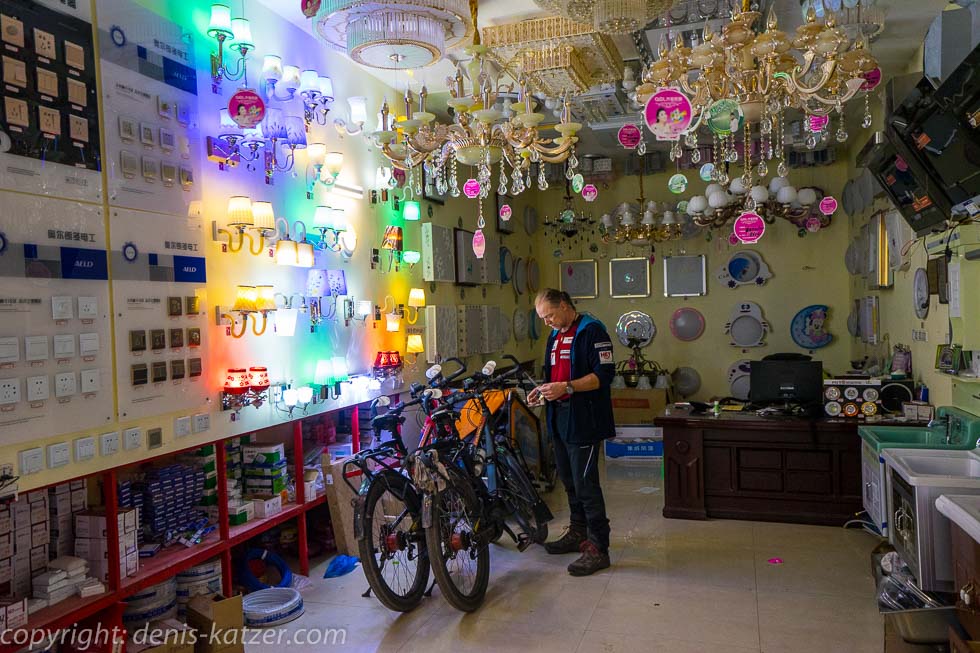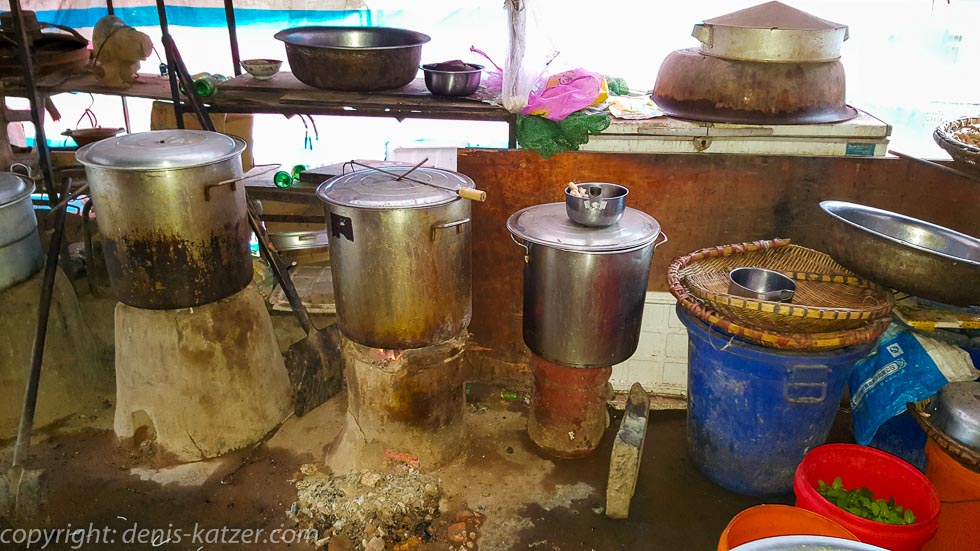
The time bomb is exploding piece by piece
N 28°39'50.0'' E 103°50'21.9''
Date:
08.04.2016
Day: 285
Country:
China
Province:
Sichuan
Location:
Xinshizhen
Latitude N:
28°39’50.0”
Longitude E:
103°50’21.9”
Daily kilometers:
50 km
Total kilometers:
16,428 km
As the crow flies:
33.40 km
Average speed:
18.0 km/h
Maximum speed:
52.7 km/h
Travel time:
2:45 hrs.
Soil condition:
Asphalt
Maximum height:
860 m
Total altitude meters:
29.028 m
Altitude meters for the day:
820 m
Sunrise:
06:47 am
Sunset:
7:26 pm
Temperature day max:
21°C
Temperature day min:
17°C
Departure:
08:20 a.m.
Arrival time:
1:00 p.m.
(Photos of the diary entry can be found at the end of the text).
As predicted by the weather forecast, we are greeted by a wet morning today. We leave our pleasant accommodation somewhat wistfully, only to find ourselves a few kilometers later in mountains covered in lush green bamboo forests. As we don’t know today whether and where we will spend the night and, above all, where we can recharge our batteries, I feel a little tense. My eyes routinely search for a free spot next to the road where we could pitch our tent, but that seems almost impossible in this region. Usually a concrete ditch separates us from the dripping wet bamboo forest, over which we cannot lift our road train, or it goes steeply up the mountains to the left and right. When we do find an open space, it is planted with vegetables.
Without having planned it, we find ourselves in an area of the Shunan Bamboo Forest, the largest bamboo forest in China. The sea of bamboo stretches over 500 hilltops and covers a total area of 120 square kilometers. Wherever we look, the bendy tree-high bamboos sway in the wind. It is an enchanting sight that makes the morning a highlight. The road meanders between 500 and 900 meters above sea level over the lush green mountain ranges. We enjoy the idiosyncratic landscape in mild temperatures of no more than 21 degrees. The average annual temperature here is around 15.5 degrees and in summer it doesn’t get warmer than 30 degrees Celsius.
Unexpectedly, a gate built in the old Chinese architectural style appears in the middle of the bamboo forest wilderness. It is the entrance to a national park where you can admire the most diverse types of bamboo. Hiking trails lead visitors through the lush subtropical vegetation. We stand in front of the explanatory sign for a long time and consider whether we want to stay for a few days to visit the beautiful nature advertised with over 60 species of bamboo, rare animals such as the salamander and Buddhist temples where monks have retreated for centuries. “I don’t know,” I think, struggling with myself, giving in to the temptation to linger here. “We have to drive 15 kilometers up into the mountains to get a room in an expensive hotel. It will be late afternoon by the time we get there, so we can’t go hiking until tomorrow. So we’d have to stay at least three nights,” I think. “Seems great,” Tanja adds. I look at the weather app on my smartphone. “Hmm, it doesn’t look good. There’s a 90 percent chance of rain tomorrow. We’d just be sliding around on the wet paths. Apart from that, we should slowly reel off a few more kilometers. It’s still at least 1,500 km to Vietnam. If we want to be there by the end of May, there can’t be too much in between.” “Okay, you’re right, let’s keep going,” Tanja is convinced.
Then, after a few climbs, we reach it, the Yangtze River, the longest river in China, which divides the country into North and South China and is called Jinsha Jiang in this region, which translates as Gold Sand River. From its source in the Tanggula Shan, the highlands of Tibet, to its mouth in the East China Sea near Shanghai, the longest river in Asia, the third longest river in the world after the Nile and Amazon, covers 6,380 kilometers. It is a sublime feeling to cycle alongside China’s most important and culturally rich water artery. This river has already traveled 3,450 km through mostly rough country to get here. Not far from here, from the town of Yibin, it is navigable to its mouth in the Pacific. We stop behind a tunnel to switch off the lights on our bikes. We use the time to enjoy the view of the Yangtze. Even if it looks more like an elongated, sluggish lake at this point and no direction of flow of the water masses can be recognized, it is an extremely dangerous river that is notorious for its flood disasters, which have cost the lives of three million people in the last 100 years alone. In recent decades, massive flooding has become increasingly frequent. In the six major floods since 2000, thousands of people have once again fallen victim to the floods. The reasons for this include land gains. More and more lakes have been drained to create farmland for the ever-growing population, which is why the Yangtze has hardly any natural escape routes left and is now flooding towns and villages even more than before. In the Hubeo region alone, there were still around 1066 lakes by 1949. As a result of the drainage, only 325 of them remain.
Another reason is the deforestation of forests that previously stored large quantities of rainwater. Meanwhile, reservoirs created by huge dams such as the 75 billion US dollar Three Gorges Dam are intended to absorb the excess water and tame the unpredictable Yangtze River. However, the construction of dams is not only an attempt to get the flood problem under control, but also to generate vast amounts of energy. With a generator capacity of 18.2 gigawatts, the Three Gorges Dam is the largest in the world to date.
I stand there and think of the huge dam that holds back the masses of water 1,200 km downstream and the catastrophic consequences for the environment and therefore also for the affected inhabitants of the region. Whenever we humans intervene in nature, a kind of echo follows. Gigantic interventions in nature also have a gigantic echo, which can even trigger earthquakes. According to some scientists, the weight of the accumulated water masses could actually trigger an earthquake. What’s more, this dam was built in an earthquake-prone area. So if an earthquake were to damage the 2,335-metre-long and 180-metre-high wall, millions of people living behind the dam would be at risk. Many critics of this structure also speak of the rapid silting up of the lake, because millions of tons of drifting sand and sediment are washed up every year and are now trapped in the lake by the dam. This means that the lake is slowly silting up, which will reduce the electricity yield enormously within a few years. However, it also means that the inhabitants of the lower Yangtze River will no longer receive natural fertilizer for their fields, which will result in a smaller harvest. This in turn means that although people have electricity, they end up with nothing to eat.
The consequences for the animal and plant world alone, with which we are more closely connected than many people would like to believe, are fatal. It is said that 2,862 plant species and 335 fish species, such as the sturgeon, are threatened with extinction as a result of the construction of the hydropower plant. On top of this, there are a further 22 animal species on the red list of endangered species. These include the resident Chinese alligator and the Chinese river dolphin, which is most likely already extinct.
The list of negative consequences of such brutal interventions in nature is long, almost endless. The probable poisoning of the 663-kilometer-long reservoir by methane gas produced by the flooded, slowly decaying vegetation seems to be just a minor side effect. The main question is how long it will take before the cocktail of waste dumps and toxins left behind by 13 cities and 657 flooded factories blows up and contaminates the water to such an extent that those who drink it drop dead. But that’s not all. The 150 million inhabitants who live above the Three Gorges Dam simply dump their waste into the river due to the lack of waste disposal sites, which means that the water arrives in the artificial lake already heavily polluted. It looks like the Chinese have created one of the most expensive time bombs ever seen on earth.
As the north of China, especially the city of Beijing with its annual water consumption of 48 billion m³, suffers from a massive water shortage, the so-called South-North Water Transfer Project, which is divided into a western, a central and an eastern route, transfers water mainly from the Yangtze River or its tributaries into over 1,200 to 1,400 kilometers of canals to the capital. 330,000 people were forcibly relocated for the water transfer project, of which the middle route alone, completed in 2014, cost 66 billion euros. Here too, the consequences for nature are incalculable. But China’s growing cities need water to survive, even if it comes from rivers contaminated by cities.
Many countries have already realized that such projects make no sense. The USA has even announced that it will no longer realize such mega-buildings, as the ecological damage is incalculable and therefore not financially viable in the long term. In the meantime, the American government has to spend billions of dollars to repair the damage caused to existing reservoir projects. Unfortunately, China didn’t want to know anything about it.
Quite the opposite. In order to realize the time bomb, two million people were forcibly resettled because of the Three Gorges Dam alone. The government has still not paid the promised compensation to many of them. The farmers of the once productive alluvial land of the Yangtze River are now trying to grow their vegetables on the high, barren mountain slopes. The yield is very poor due to the inferior soil. The activist Fu Xiancai, who denounced the abuses on ARD’s Tagesthemen magazine, was then brutally beaten up, leaving him paralyzed from the neck down. After the local authorities refused to pay for a vital operation, the German embassy stepped in to help the seriously injured man.
As it stands, the time bomb is already beginning to explode piece by piece. In October 2007, the government decided to resettle a further 4 million people for ecological reasons.
Nevertheless, the madness continues. Beijing plans to build 12 more power plants above the Three Gorges Dam by 2020. The reason: the dams are intended to help prevent thousands of tons of alluvial sediment from entering the lake of the Three Gorges Dam, ultimately silting it up and increasing the pressure on the dam wall. Other reasons include power generation, irrigation of fields, making the river navigable and flood protection. 13,000 of the farmers who have lived there for centuries are being driven off their land, sometimes by force. They allegedly receive compensation of €1,000 for 674 square meters of land. “That’s not enough,” say those affected, as the money is not enough to cultivate new land. If they resist or protest, they run the risk of being arrested. Because of the underdeveloped legal system in China, ordinary people have no chance of a hearing or an appeal for too low or no compensation payments. It is certainly worth mentioning that the economic interests of many countries play an important role in such mammoth projects. The German government provided a billion-euro guarantee for Siemens, which in turn supplied the generators and transformers. The investment bank Morgan Stanley and the Canadian government are among the most important investors. But the Chinese people must also contribute their share of the financing through a special tax.
“Let’s get going!” Tanja calls out, tearing me away from my destructive thoughts. “Okay,” I reply, walk back to my e-bike, get on the saddle and let the pedals spin. A four-kilometer tunnel gives us the luxury of not having to drive over the high pass. At first we are happy about this, but the air inside is so polluted that we find it difficult to breathe. As soon as the dark tube spits us out on the other side, we see another yawning black hole in front of us. There is a lively market right in front of it. A muddy, rain-soaked road leads to the left just 50 meters before the tunnel. On the hillside there, the typical ugly, multi-storey residential buildings have replaced the once beautiful farmhouses. “Is there a hotel there?” asks Tanja doubtfully. “Let’s give it a try,” I reply and kick my steed across the mud into the Chinese settlement called Xinshizhen. “Binguan dsai na-li?” (Where is the hotel?), I ask a couple of young women, hoping not to get nuts again. One of the teenagers tells us to call them. “There really does seem to be somewhere to stay in this town,” I say to Tanja, smiling confidently. “Deng”, (wait) I think I understand. It only takes five minutes before a man on a moped rattles up to us and asks us to follow him. “Xie xie,” I thank the girl. Then we drive after the Chinese. He is driving his vehicle up a very steep hill. We shift into first gear and also pant upwards. When we reach the top, we are actually standing in front of a simple hotel with clean rooms. This time our bikes are allowed to spend the night in a lamp store. After we have covered them up and the equipment is in the room, we go to one of the many simple Chinese street restaurants and satisfy our growling stomachs with a delicious noodle soup for 7 yuan (€0.95)…
If you would like to find out more about our adventures, you can find our books under this link.
The live coverage is supported by the companies Gesat GmbH: www.gesat.com and roda computer GmbH http://roda-computer.com/ The satellite telephone Explorer 300 from Gesat and the rugged notebook Pegasus RP9 from Roda are the pillars of the transmission

